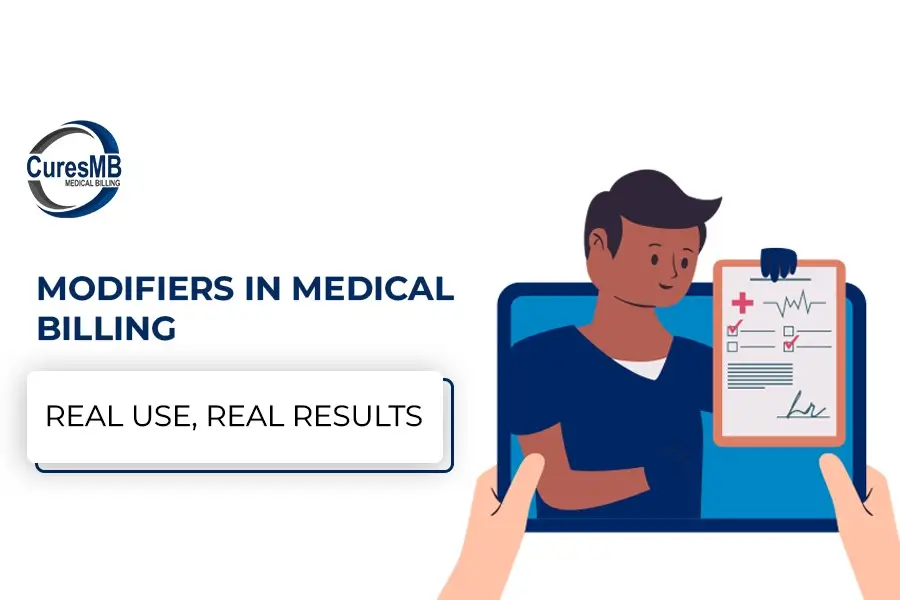
In the domain of healthcare billing, modifiers in medical billing play an important role. If you’re a provider wondering why claims get denied even when the services are correct, you might be missing one thing: the right modifier.
Modifiers are two-character codes (usually numbers or letters) added to CPT or HCPCS codes. They help explain the conditions of a service, such as:
Without these clarifiers, payers like Medicare or commercial insurers may misinterpret the service and deny the claim.
Let’s break down the types of modifiers in medical billing and how they apply:
Here’s a list of modifiers in medical billing that come up frequently:
Modifier | Meaning | Example Use |
25 | Important, separately recognizable E/M service | Office visit + slight procedure |
59 | Different procedural service | PT and OT services same day |
76 | Replication procedure by the same provider | The same lab test was repeated |
50 | Bilateral procedure | Surgery on both knees |
91 | Replication clinical diagnostic lab test | COVID test repeated same day |
These commonly used modifiers in medical billing are often the difference between fast reimbursement and frustrating denials.
Let’s bring this closer to real-life use. A provider at a physical therapy clinic billed 97140 (manual therapy) and 97530 (therapeutic activity) for the same session. The claim was denied.
Why? Not at all, modifier 59 was added to the expression that the services were different.
After our team at Cures Medical Billing reviewed the claim, we corrected the coding, applied modifier 59, and the claim was paid on resubmission. That’s the real power of knowing how to use modifiers in medical billing.
Our goal is to streamline your healthcare revenue cycle management, give you the financial freedom your practice deserves, and take control with a partner specializing in provider RCM optimization and services excellence.
Access essential company data with a simple click through the 'Download Company Info' feature.
Here are real-world steps you can follow:
When in doubt, talk to experienced coders. Cures Medical Billing is here for that.
Beyond the basics, these are also critical:
Each has specific use cases, and using them correctly protects your revenue.
We worked with a cardiologist who performed echocardiograms and interpretations. He only used CPT code without modifiers and wasn’t getting paid for the professional component.
After a quick review, we applied modifier 26, and the claims started to pay appropriately.
Lesson? Even minor modifier errors can cost you thousands.
Understanding modifiers and their description in medical billing is not just about compliance; it’s about getting paid faster, with fewer denials. Every code expresses a section, and modifiers fill in the details.
At Cures Medical Billing Services, we don’t just code, we optimize your revenue cycle. Whether you’re confused about modifier 59 or wondering how to apply modifier 50, we’re here to help.
Ready to stop losing revenue to wrong modifiers?
Contact Cures Medical Billing Services for expert support.
Modifiers are two-digit codes added to CPT or HCPCS codes that provide extra details about a medical service like whether it was bilateral, repeated, or performed separately. They’re crucial because they prevent claim denials by giving payers the full picture. At Cures Medical Billing, we’ve seen simple modifier errors delay thousands in payments.
Modifier 25 is one of the most frequently used in outpatient settings. It’s applied when an E/M service is separately identifiable from a procedure done the same day. Just be careful—overusing it without documentation can trigger an audit.
First, check the payers’ guidelines Medicare and commercial insurers can vary. Then look at the clinical documentation to justify the modifier. If unsure, consult experienced billers like us at Cures, who can guide you through the process based on real billing cases.
Modifier 59 is used to show that procedures are separate and distinct, especially when normally bundled. Modifier 51 just indicates multiple procedures done at the same time. Using the wrong one can cause bundling errors and underpayment.
Telehealth billing often requires modifier 95 to indicate the service was provided via real-time audio and video. If it’s missing, your claim might get denied even if the service was fully documented. This is especially critical for Medicare billing.
Modifier 59 is used to show that procedures are separate and distinct, especially when normally bundled. Modifier 51 just indicates multiple procedures done at the same time. Using the wrong one can cause bundling errors and underpayment.
Discover Cures Medical Billing Services Across Different States
FL
NY
ML
CO
NJ
AZ
TX
CA
WA
We are a team of national medical billing service experts based in Astoria, NY, committed to providing ongoing value to our customers. We leverage technology and implement best practices to provide high-quality and cost-efficient medical billing solutions from domestic locations, enabling customers to achieve their business goals. Cures Medical Billing is the best option for any medical billing needs.
Medical billing around Astoria, NY, and beyond is our core competency and our specialists will efficiently manage all your billing needs. Our medical billing specialists have over 12 Plus years of experience with all security technologies to ensure data integrity for our customers. Using our medical billing service, anyone can make their medical billing task less resource-consuming.
Efficiency & precision in healthcare financial management with Cures Medical Billing, your trusted partner for smarter, faster, and more accurate billing solutions.
This site uses cookies. Read our Privacy Policy